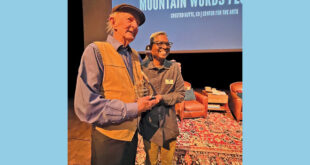With a flurry of snow and high winds the ski area closed for the season last weekend. It was a good winter. The storms came, not always as predicted, but often and good enough. The sun shone. Fun was had, but also some hard times. There were some big losses that, while devastating, served as a reminder of the importance of community and connection. The worry, however, is that just as the snow melts, these reminders will fade.
Standing in the parking lot of the community school on Monday afternoon, waiting for the kids to rush out the doors in a wave of partially donned snowsuits and enthusiasm, the adult conversation turns to the upcoming April break—the annual exodus to escape the mud and melt for a few days and shore up the Vitamin D reserves.
There are plans to camp and ride bikes locally at Hartman’s, to go a little farther for the deserts of Fruita and Moab. Some families are pumping up rafts and heading for the Colorado or the Green. Others are taking off to visit family, and some are going bigger, booking tickets and packing adventure rigs for the Caribbean, the Seychelles, the Dolomites.
In a place where a high percentage of the “dirt bags” and “ski bums” are pedaling $5,000 mountain bikes, the variety in destinations can reflect, to some degree, the income diversity present within the school, and the larger upper valley.
Throughout the last decade of growth, there’s been an ongoing conversation about the need and protection of “One Valley.” It’s an approach based on the thought that we will flourish or perish as a unified group. While the sentiment is lovely, the reality is that decisions are being made daily at the individual, group and government level, which suggest a growing disparity on the home front. And the kids are noticing.
In childhood, friendships are often dictated by proximity. Without access to cell phones for arranging meet-ups or wheels to travel beyond the neighborhood, it’s the kids who live down the street or around the block from one another that play together the most. This is great. There’s simplicity in riding down to Sally’s house, knocking on the door and heading to the park. However, it can in our situation, result in the formation of cliques based on socio-economic status.
We have town kids and Buckhorn kids. CB South kids. Mountain kids. Within these groups there are others. Those who live in deed-restricted housing, and those whose families are building homes to be featured in Architectural Digest. Again, that’s all fine and good. The issue however, is when we as a community and as a town begin to exacerbate these differences through our planning and development decisions.
This is going to feel a little all over the place, but stick with me. It circles back…
Recently, the Crested Butte town council has been working to determine a new parking plan for town. The quick and dirty of it, as stated by councilmember Kent Cowherd in the April 1 meeting, is to “de-emphasize cars and encourage pedestrians and bikes.” That sounds great, until you’re a family with preschool and elementary-aged children living in CB South or Riverbend and trying to take the kids up to the mountain. Couple that with the push-back that came over the proposed CB South to town bike path connector that occurred last summer and the message is firmly one of “if you’re not wealthy or lucky enough to live or vacation in the town of Crested Butte proper, we don’t want you here (except to work service jobs but good luck with your commute).”
The Crested Butte town council is just that, the TOWN council, and whether or not anyone wants to say it, much of the valley’s wealth centers in town. This in turn impacts decision making. As a wise editor once told me, “Somehow the rich always make it out okay.”
Back to the kids. Our community, and our community school, is made up of more than town, yet, it seems it is the town’s needs and desires that are determining how the Upper Valley will look in the years to come. So, I ask, do we want to cater to the few, or embrace the many?
It is up to us to show our kids that where we live in the valley matters much less than how we live. That even though we all have different incomes and take different vacations, we are all valued in the valley. When we begin to restrict access to town, whether through limiting parking or stopping the development of pedestrian friendly connectors, we are reinforcing the idea of the haves and have nots, and that is the opposite of connection.
Cliques weren’t fun in middle school, and they sure as shooting aren’t fun now. Let’s show our kids that we can do better.
(Aimee Eaton is a former reporter for the CB News and a mother of three local kids ages 5, 7 and 9. They’re heading to the desert for spring break.)
 The Crested Butte News Serving the Gunnison Valley since 1999
The Crested Butte News Serving the Gunnison Valley since 1999



